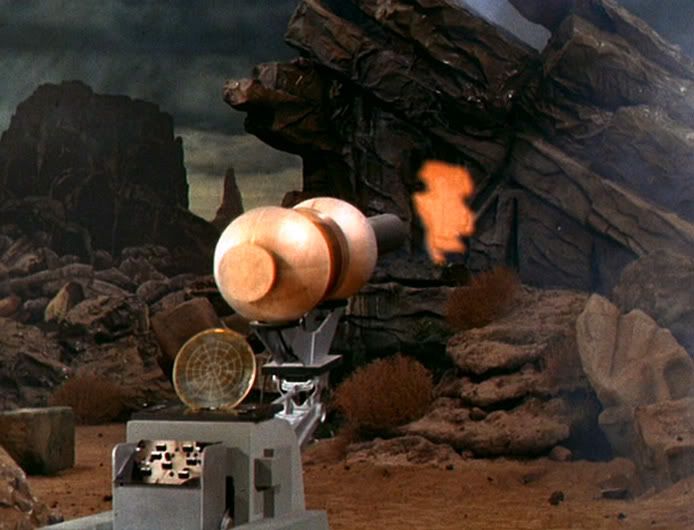1. Regarding its shape and articulation, there's a pretty sweet Google SketchUp model here:
http://sketchup.google.com/3dwarehouse/ ... 7a183337d9
or the weapon alone:
http://sketchup.google.com/3dwarehouse/ ... 7a183337d9
While we never see the front of the weapon in reality, I would wager it's entirely possible that the front armature rotates, allowing easy upward firing.
2. Unless they had information that the underground complex was
very large (i.e. spanning beyond the horizon from ground level), then it doesn't make sense to think that they would've needed to bring one of the ship's weapons down. Phasers would have no trouble firing through the atmosphere, even if the ship was placed at a sufficient angle.
2a. Of course, if these really
were lasers, then there
could be issues shooting through so many kilometers of soupy atmosphere. We're still working on such issues now, though we're pretty good at dealing with it for low-power applications. Extremely high-energy lasers, however, can ionize and otherwise screw up the atmosphere, causing the beam to effectively block itself by being too powerful. We're working on that, too.
However, the Trek canon strongly suggests that lasers should not have been in use.
3. Wireless invisible power transfer technology is something that was virtually forgotten until DS9's Cardassian Orbital Weapons Platforms. I've been planning to either blog about the "Cage" weapon and its relation to those or make a page on it for awhile.
That said, it's intriguing, because unlike the usual power transfer beams seen in TNG, or a wire/conduit system like we might otherwise expect, this technology is not obviously physically blockable, nor is there any evidence of any beam from orbit that is being received by the weapon (after all, where is the receiver, and if there's so much energy, where's any leakage or other evidence of thermodynamic inefficiency?).
I presume it's like some sort of subspace Tesla coil effect, but in this example it seems to stress the sending unit something fierce. The alternative is that we take your comment on "beam power down to it" literally, and assume that some sort of transporter-like effect is being used to power it, like beaming plasma directly into a conduit constantly. That would be sufficiently inefficient and wacky to make it strain the ship.
4. It may float normally, given that the big large base is certainly thick enough to house antigravs. Indeed, it would make sense that it wasn't shown floating, since it may not be a good idea in general to float while firing enormous wind-producing blasts.
That said, I would agree that it is probably not intended as a ground combat weapon on the front lines of a ground war, unless some very specific conditions were in play.
That is, we're imagining some small group of men trudging about the countryside hauling this thing to try to get it into position to shoot the badguys from line-of-sight, meaning they'd be under fire. In that case, it would be worse than a horse-drawn artillery piece, because (a) you'd clearly be within range of your enemies while setting up, unlike even horse-drawn artillery (unless you were setting up while the enemy already had their artillery set), and (b) it would still require a starship or other ground site producing power, meaning you're hauling this thing around and you can't even use it without a ship to operate it. No ship, no boom-boom.
To my mind, then, a weapon like that would best serve in a role similar to mobile ICBM launchers or Iraq's mobile SCUD launchers, inasmuch as being a mobile and potentially hard to detect defense platform serving as a piece of a larger defense pie. For an example, a shielded colony like Ajilon Prime could've had such weapons on its shield periphery, powered by the same generators powering the shield, meaning the operators would be protected behind the colony shields. If for some reason the shield bubble needed to be tightened or perhaps if a generator was weakening, the antigravs could be turned on and the cannon moved to a safer or otherwise superior location. And, during non-alert conditions, the cannon would not be in a fixed location and thus an enemy could not simply drop in from warp and strike a pre-planned set of coordinates to take out the assorted cannons.
It might also be a siege weapon. One can imagine ground troops at a forward base with on-site power production and wireless power transmission using it to wear down the shields of a colony town like those on Ajilon Prime from a fairly safe location without having to tie up an entire starship for the purpose over a long period of time.
In ether case, the same sort of single-point-of-failure problem that would later bedevil the Cardie OWPs would also apply here. On the other hand, if you did have to lose a cannon to the enemy, it would be a reasonably simple matter to shut it down . . . just stop powering it, or overload it on its power frequency, or whatever.
(And yes, such a thing could also be used as a mega-drill, but not a great one. As dangerous as its use seemed to be, and with the wireless power transmission requirement, drilling laterally from underground (as often happens now) would seem completely unworkable.)












